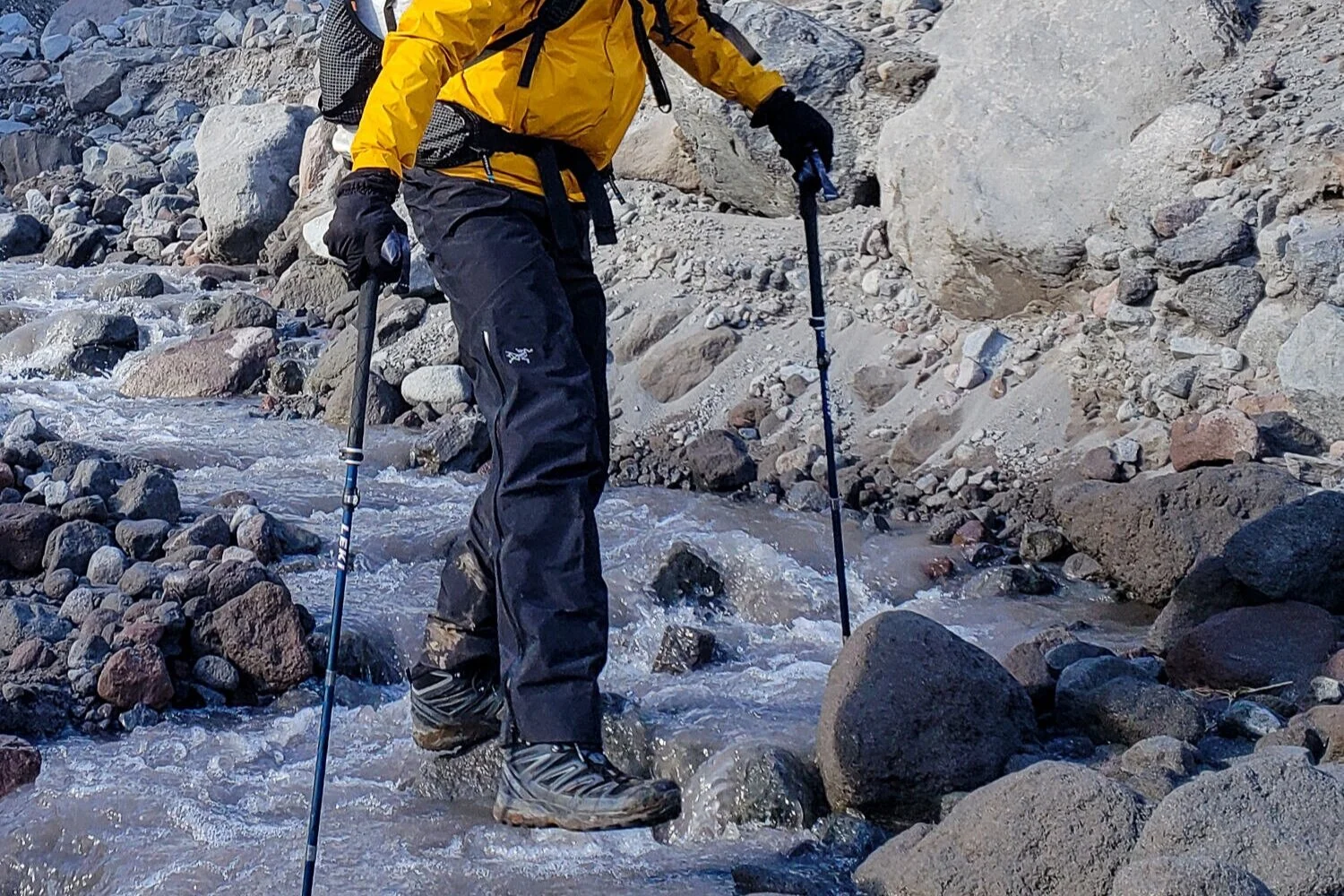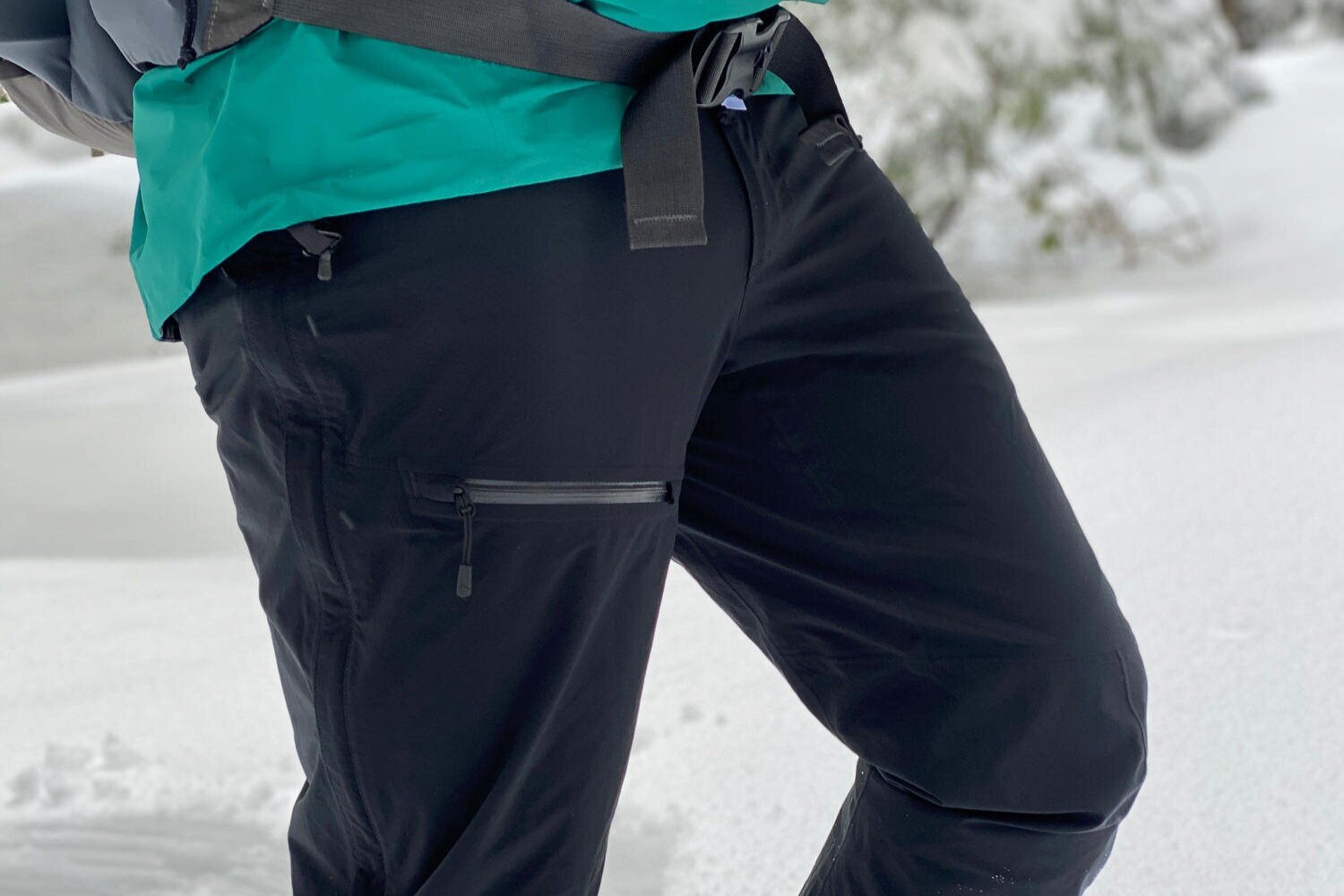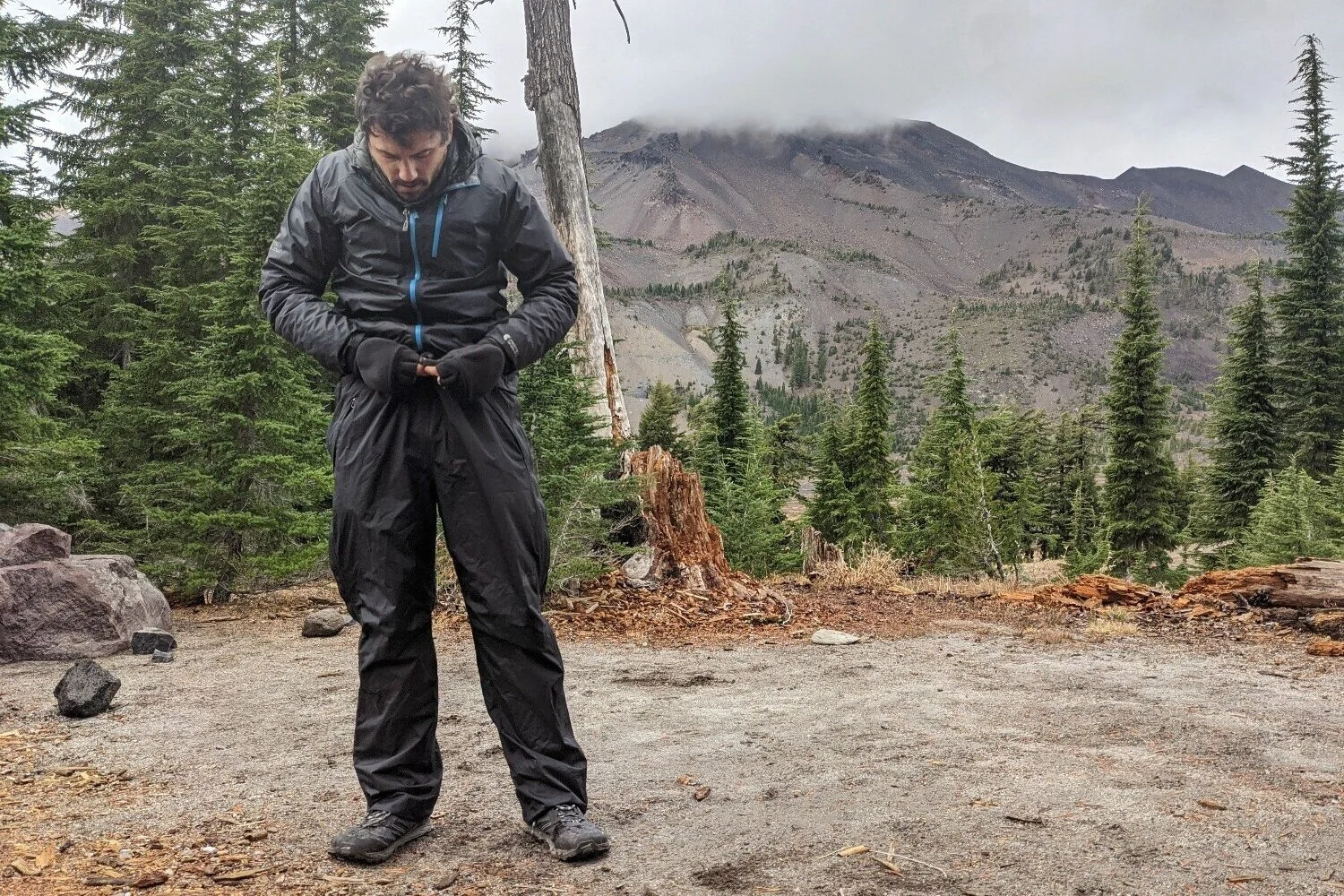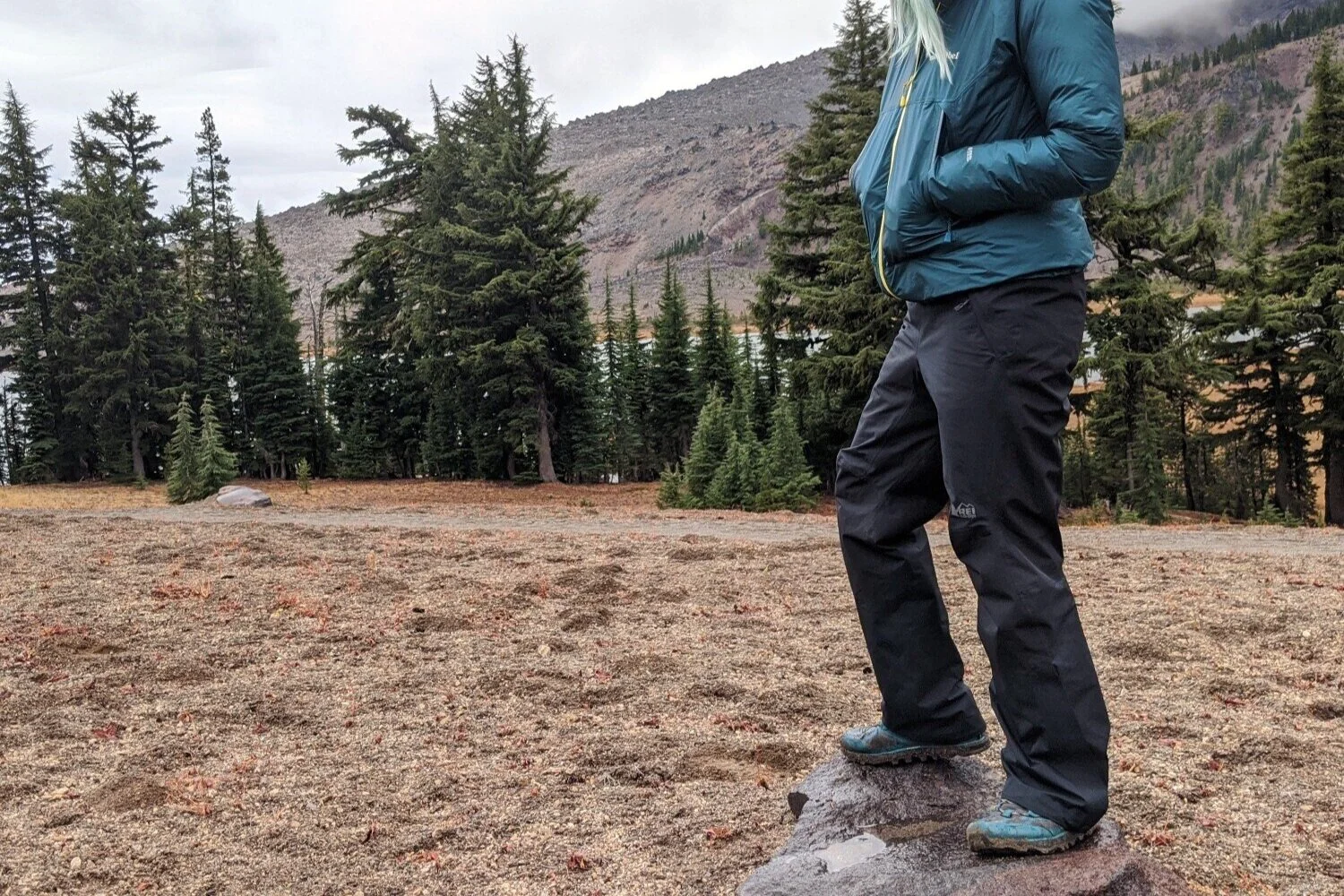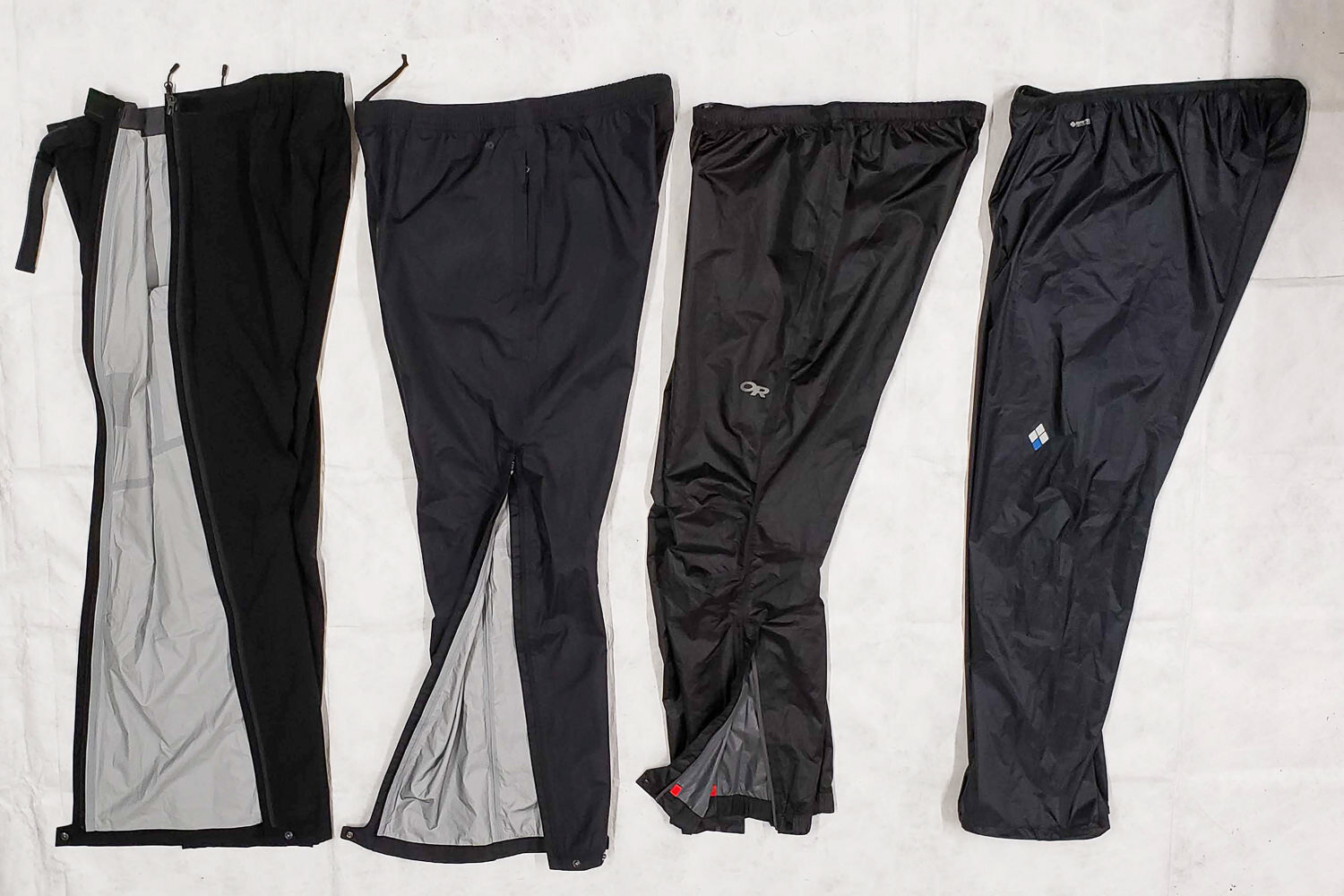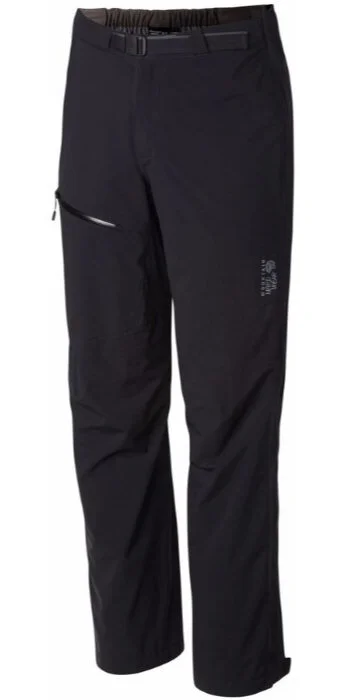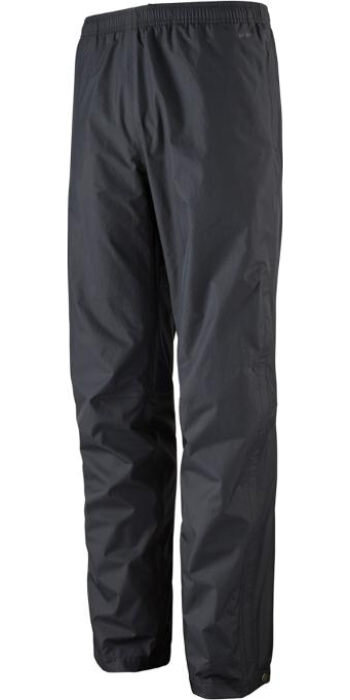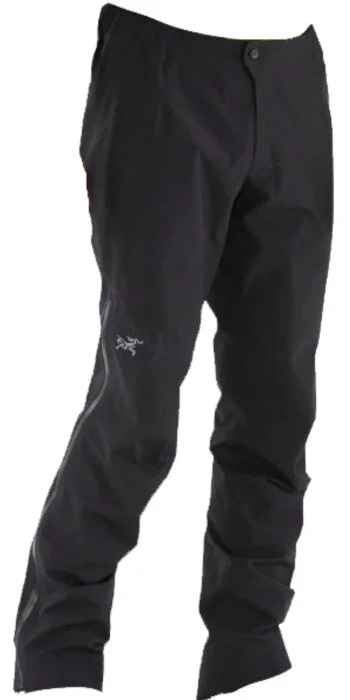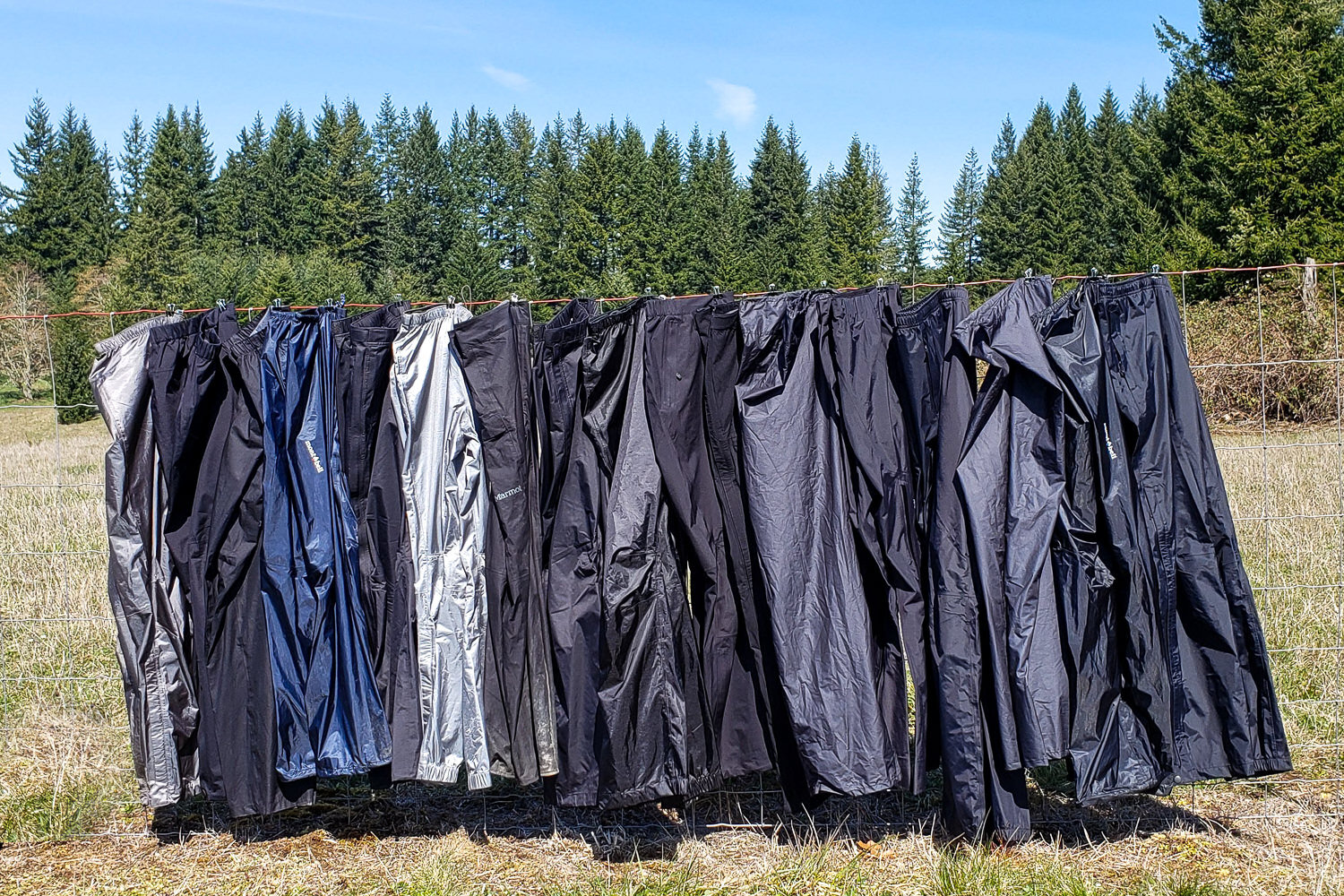Author: Heather Eldridge | Editor: Dave Collins
Last Updated: February 13, 2023
A trusty pair of rain pants should be in every outdoor adventurer's gear arsenal. Not only will they keep you dry when the skies open up, but they’ll also cut the wind and hold in valuable body heat to keep you safe and warm in the backcountry.
We’ve spent countless hours researching and hiking through the drizzle to bring you this list of the best rain pants on the market.
Quick Recommendations
Check out this quick list of our favorite rain pants, or continue scrolling to see our full list with in-depth reviews.
Best rain pants overall for comfort & functionality: Mountain Hardwear Stretch Ozonic Men’s / Women’s
Best affordable ultralight rain pants: Outdoor Research Helium Men’s / Women’s
Durable rain pants at an affordable price: Patagonia Torrentshell 3L Men’s / Women’s
Best budget rain pants: REI Rainier Full-Zip Men’s / Women’s
Great quality for the price rain pants: REI XeroDry GTX Men’s / Women’s
Minimalist ultralight rain pants for hiking & backpacking: Montbell Versalite Men’s / Women’s
Lightest rain pants for hiking & backpacking: Zpacks Vertice Men’s / Women’s
High-quality lightweight rain pants for technical use: Arc’teryx Zeta SL Men’s / Women’s
The comfy Mountain Hardwear Stretch Ozonic Pants are durable which makes them perfect for snowshoe hikes
WHAT’S MOST IMPORTANT TO YOU IN RAIN PANTS?
PRICE - We tend to be willing to spend a bit more on high-quality clothing that we plan to wear a lot. Comfort, durability, and a well-designed fit usually trump cost in our books, but we recommend quality options at a variety of price points in our top picks below.
The REI Rainier Full-Zip Pants are an affordable 2.5-layer rain pant
COMFORT - In these modern times, you don’t have to settle for uncomfortable waistbands, pants that restrict your movement, or materials that feel plasticky. There are some great options that are designed with comfort, movement, and hip-belt compatibility in mind.
WEIGHT & PACKABILITY - Many lightweight rain pants pack down small and work well for hiking and backpacking. Most of the time, lightweight minimalist pants are all you really need to provide protection from light showers and wind.
Comparing the weight and bulk of the Men’s rain pants (size large)
DURABILITY - Ultralight rain pants are great when you want to keep weight to a minimum, just remember that lightweight fabrics tend to wear out quicker. If you expect to contend with a lot of severe weather or rugged terrain, you might want to go with a thicker pair of heavy-duty rain pants.
The REI XeroDry GTX Pants are a quality pair of rain pants at a great price point
ZIPPERS - Zippers on rain pants have two functions: they add ventilation and help you thermoregulate, and they make it easier to put on and take off the pants. Rain pants that have full-length zippers allow the most airflow and are the easiest to put on and take off without removing your shoes. That said, zippers add bulk and weight.
BEST RAIN PANTS of 2023
BEST RAIN PANTS OVERALL FOR COMFORT & FUNCTIONALITY
MSRP: $175
MEASURED WEIGHT (MEN’S LARGE): 11 oz.
PROS: Comfortable (stretchy), quiet, full-length zippers for ventilation and easy on/off, pack into their own pocket, men’s have a built-in belt
CONS: A bit heavier and bulkier than ultralight options, limited uses for pocket due to placement
BOTTOM LINE: If you’re all about comfort, you’ll love the Mountain Hardwear Stretch Ozonic (men’s / women’s). The soft stretch fabric makes them quiet and gives them an unrestricted feel that’s relaxed and easy to move in. They also have full-length zippers for ventilation. This also means that you can easily put them on or them take off on the fly. Some ultralight pants weigh less than the Ozonics, but we like them so much that we take them backpacking trips when there’s significant rain in the forecast. The Ozonics are super comfy and are hands down some of the best rain pants we’ve ever worn.
BEST AFFORDABLE ULTRALIGHT RAIN PANTS
MSRP: $130
MEASURED WEIGHT (MEN’S LARGE): 6.6 oz.
PROS: Affordable, ultralight, pack into their own pocket, more durable than most UL pants
CONS: Limited ventilation and more difficult to put on/take off without removing shoes due to short zippers
BOTTOM LINE: The Outdoor Research Helium (men’s / women’s) are the most affordable ultralight pants we’ve tested. Their low weight and packability is ideal for activities like hiking and backpacking when keeping weight and bulk to a minimum is key. They’re made with thin materials, but this latest iteration of the Helium Pants is tougher than previous versions and is more tear-resistant than most ultralight rain pants. The Helium pants are a great value for the price, which makes them a smart option for backpacking on a budget.
DURABLE RAIN PANTS AT AN AFFORDABLE PRICE
MSRP: $129
MEASURED WEIGHT (MEN’S LARGE): 11.8 oz.
PROS: Affordable, durable, cuff-to-thigh zippers for ventilation and easy on/off, hand pockets, pack into their own pocket
CONS: Heavier/bulkier than some, material is a bit stiff
BOTTOM LINE: The Patagonia Torrentshell 3L (men’s / women’s) are an affordable and durable option with solid construction. If weight isn’t your chief concern, the thicker fabric used in these pants offers better protection from brush and heavy rain than ultralight pants. Plus, they have convenient pockets for your hands, keys, or a wallet. Because of these qualities, the Torrentshell Pants are an excellent value for front-country use.
BEST BUDGET RAIN PANTS
MSRP: $100
MEASURED WEIGHT (MEN’S LARGE): 13.2 oz.
PROS: Affordable, full-length zippers for ventilation and easy on/off, hand pockets, pack into their own pocket
CONS: Heavier/bulkier than some, not as comfortable against the skin as some
BOTTOM LINE: If you’re on a budget and weight isn’t your chief concern, the REI Rainier Full-Zip (men’s / women’s) are a great option for all-around use. They’re well-designed and have all the adjustments one could want. The Rainier Pants have great hand pockets, full-length zippers, and an adjustable draw cord at the waist to keep them from slipping down. Because they’re heavier and bulkier than some, the Rainier Pants are best suited for times when weight doesn’t matter as much. Overall, the Rainier are well-designed and are some of the best affordable rain pants on the market.
GREAT QUALITY FOR THE PRICE
MSRP: $149
MEASURED WEIGHT (MEN’S LARGE): 9.9 oz.
PROS: Durable, quiet, lightweight, hand pockets, pack into their own pocket, shoelace hook
CONS: Limited ventilation and more difficult to put on/take off without removing shoes due to short zippers, waistband cord lock slips
BOTTOM LINE: The REI XeroDry GTX (men’s / women’s) are a high quality option for a modest price. The durable outer fabric feels soft and is quieter than most rain pants. These pants only have ankle-length zippers, which means they’re a bit more limited on ventilation and are a little tougher to put on without removing your shoes. That said, if you want high-quality pants that are lightweight but still durable, the XeroDry are one of the best options we’ve found, especially at this price point.
MINIMALIST ULTRALIGHT RAIN PANTS FOR HIKING & BACKPACKING
MSRP: $169
MEASURED WEIGHT (MEN’S LARGE): 3.4 oz.
PROS: Ultralight, pack down small
CONS: Expensive, less durable than others, limited ventilation, more difficult to put on/take off without removing shoes due to lack of zippers, no pockets
BOTTOM LINE: If you prefer a streamlined clothing system, the Montbell Versalite (men’s / women’s) are a good minimalist option. They’re incredibly lightweight and they pack down really small, which makes them ideal for activities like hiking and backpacking. The thin material isn’t as durable as some, but it makes the Versalite Pants feel fairly breathable and comfortable to hike in even without zippers for ventilation. We recommend keeping Tenacious Tape on hand for repairs on remote trips. If you’re looking for a simple, lightweight pant without unnecessary bulk, the Versalite Pants are a solid choice.
LIGHTEST RAIN PANTS FOR HIKING & BACKPACKING
MSRP: $149
MEASURED WEIGHT (MEN’S LARGE): 2.95 oz.
PROS: Ultralight, pack down small, extra wide legs for easier on/off increased airflow
CONS: Thin lightweight materials are less durable, more difficult to put on/take off without removing shoes than pants with zippers, boxy fit, no pockets
BOTTOM LINE: If ultimate weight savings is what you’re after, the Zpacks Vertice (men’s / women’s) are tough to beat. The men’s size large pants weigh less than 3 ounces on our scale! The Vertice Pants have extra-wide legs for airflow and easier dressing. That said, they’re still a little more work to thread your foot through than pants with full-length zippers. These pants are designed to be as lightweight as possible, which sacrifices some durability. With that in mind, the Vertice Pants are a great option for hikers who are dedicated to keeping their backpacking gear as lightweight as possible.
HIGH-QUALITY LIGHTWEIGHT RAIN PANTS FOR TECHNICAL USE
MSRP: $249
MEASURED WEIGHT (MEN’S LARGE): 9.25 oz.
PROS: Lightweight, durable, stylish fit, pack down small, cuff-to-thigh zippers for ventilation and easy on/off, high-quality waterproof zippers
CONS: Expensive, material is a bit stiff, no pockets
BOTTOM LINE: The Arc’teryx Zeta SL (men’s / women’s) offer a great balance of low weight and solid durability. The premium materials feel tougher than most other pants of a similar weight. The Zetas also have a trim, natural-looking fit that we dare say is stylish for rain pants. The Zetas are a good choice for technical pursuits that may require crampons since they’re reinforced around the cuffs where they’re most susceptible to damage. The price is a bit steep, but the Zetas are worth the investment if you know you’ll be wearing rain pants a lot and want something that looks and feels good.
Honorable Mentions
The following rain pants didn’t make our final list, but they’re very popular and they’ve still got a lot of good things going for them. You never know, one of these pants might be perfect for you:
Rab Kinetic 2.0 Men’s / Women’s - comfortable and stretchy waterproof softshell pants with a slim fit
Arc’teryx Beta AR Men’s / Women’s - expensive, but very durable and well-designed pants that are tough enough for everyday wear or technical alpine ascents
Marmot PreCip Eco Full-Zip Men’s / Women’s - budget-friendly pants, like the REI Rainier Full-Zip (above), but a tad lighter weight and a few dollars more expensive
RAIN PANTS ALTERNATIVES
Rain skirts and kilts have become a popular alternative to rain pants in the ultralight backpacking world. The pros are that they’re easier to put on and take off, they’re often lighter, and they have great airflow. The cons are that they aren’t effective at trapping body heat, protecting the lower legs, or blocking wind like rain pants are. Rain skirts can also get caught on brush easily in areas where trails are overgrown.
Some of the best rain skirts & kilts we know of are:
Rain pants can protect your bottom layers from wet snow
CRITICAL RAIN PANTS CONSIDERATIONS
VENTILATION - It’s always nice to have the option for more airflow. Zippers along the sides of rain pants are great for letting excess heat escape if you get too warm while hiking uphill or being active. Some ultralight rain pants without zippers (especially those with a roomy fit) breathe almost as well because they’re typically made with thinner materials.
HOT TIP: Getting hot and sweating when you’re working hard in rain gear is inevitable. The best way to deal with moisture from the inside is to “start cold” if you know you’ll be hiking uphill. Don’t put your rain pants on until you start to feel chilled (see “When to Put Your Rain Pants on” below). Wearing lightweight synthetic hiking pants, leggings, or base layer pants underneath will help move moisture away from your skin and keep you more comfortable too. Dump heat as you warm up by unzipping side zippers or releasing ankle cuff adjustments. You can also do things like slow your pace, take off your hat, and expose your neck. If you absolutely hate hiking in rain gear because you get hot, consider wearing quick-drying hiking clothes and using a hiking umbrella instead.
CONDENSATION - If you’re wearing rain pants on a cold rainy day, condensation will likely form on the inside fabric. This leads many people to think that their rain gear is failing even though it’s still waterproof and doing its job. If you feel wetness forming inside your pants, don’t worry too much about it and keep truckin’. It’ll likely evaporate with body heat as long as you’re wearing appropriate wicking layers underneath. As long as you’re moving, you’ll still be relatively dry and comfortable. For maximum comfort when backpacking, make sure you’re taking good care of your rain gear (airing it out at night and avoiding bushwhacking), and that you have something nice and dry to change into at the end of the day.
Comparing materials of rain pants
2-, 2.5- & 3- LAYER PANTS - The number of layers rain pants have helps determine how waterproof and breathable they will be. 2-layer pants are the most common and affordable and they’re typically constructed with a Durable Water Repellent-coated (DWR) outer shell and a breathable liner (usually mesh). 2.5-layer pants are typically the lightest and are made with the same DWR-coated outer. The inner layer of 2.5-layer pants is a thin polyurethane laminate or coating meant to keep sweat and dirt from clogging the breathable pores of the pants from the inside. 3-layer pants are the most effective and they incorporate all of the above - they have a DWR-coated outer shell, a breathable and waterproof midlayer, and then a polyurethane lining for the innermost layer.
RAIN PANTS TIPS
WHEN TO PUT YOUR RAIN PANTS ON - Because rain pants retain body heat, you’ll probably sweat and get wet from the inside if you put them on too soon. Most of the time, we prefer to hold off on putting them on until we start to feel chilled. As long as you’re wearing synthetic clothing, it’s ok if it gets a little wet before you put rain pants over the top. If you keep moving, you’ll warm up quickly and the layers beneath will start to dry. There are times when we put rain pants on before we hit the trail, such as dewy mornings when there’s lots of wet vegetation and we don’t expect to be going uphill right away. Confidence in your ability to control your temperature with clothing and movement will come with practice.
MAKE CHANGING ON THE FLY EASIER - Taking off your shoes to change into rain pants on the trail can be a hassle, but a simple solution to avoid getting your feet wet is to stand on a sit pad, like a Therm-a-Rest Z-Seat Pad. A sit pad will also help protect the backside of your rain pants when you sit and make your pants last longer.
Standing on a Therm-a-Rest Z-Seat Pad to put rain pants on mid-hike
To learn more tips for hiking and backpacking in the rain, check out the following links:
Need More Gear Advice?
If you liked this list, you’ll love the CleverHiker Gear Guide where we test and recommend tons of outdoor adventure gear from a variety of categories. here are some links to popular articles:
We own and use all of the rain pants we recommend
Why Trust Us?
We fully understand how tough it is to find trustworthy gear advice, and that’s one of the main reasons we built CleverHiker. We live for outdoor adventure, and we take these guides very seriously. Here are some of the reasons you can trust us:
Our choices are completely independent and based on personal experience.
We’ve logged over 10,000 trail miles and test outdoor gear for a living.
We own and field test every product we recommend, which is sadly not the norm.
We travel to industry trade shows to learn about upcoming product innovations.
We constantly update our guides when new products launch.
We treat our recommendations as if they were for our family and friends.
We’re lifelong learners and we’re always open to constructive criticism. If you think we’ve missed a product or got something wrong, we’d love to hear your feedback.
MORE INFORMATION
We hope this guide helps you find the perfect pair of rain pants for your needs. If you have more questions or a suggestion, we’d love to hear from you! Sign up for our newsletter to stay updated on our latest posts then visit our Facebook page and Instagram to join the community conversation.
If you found this guide helpful, please give it a share on social media! Also, be sure to check out our CleverHiker Gear Guide to see all of our top gear picks.
Thanks for reading and happy trails!
Some of the links on this page are affiliate links, which means we may receive a modest commission if purchases are made through those links. This adds no cost to our readers and helps us keep our site up and running. Our reputation is our most important asset, which is why we only provide completely honest and unbiased recommendations.


